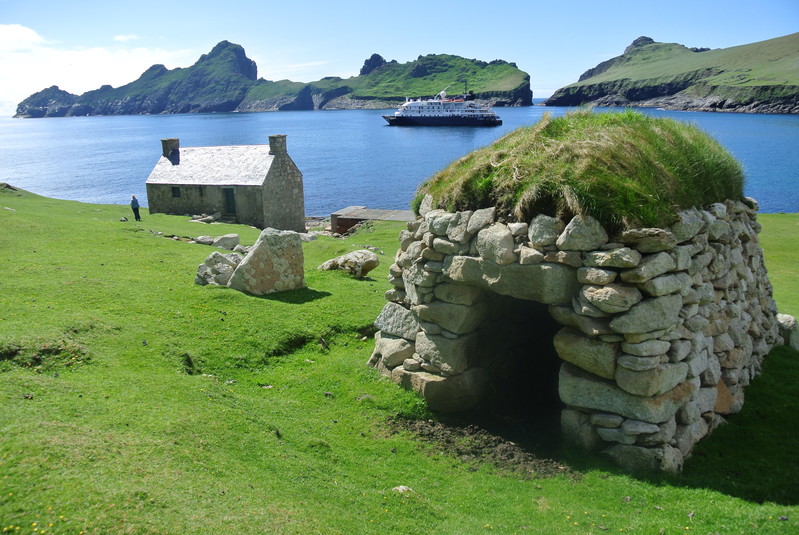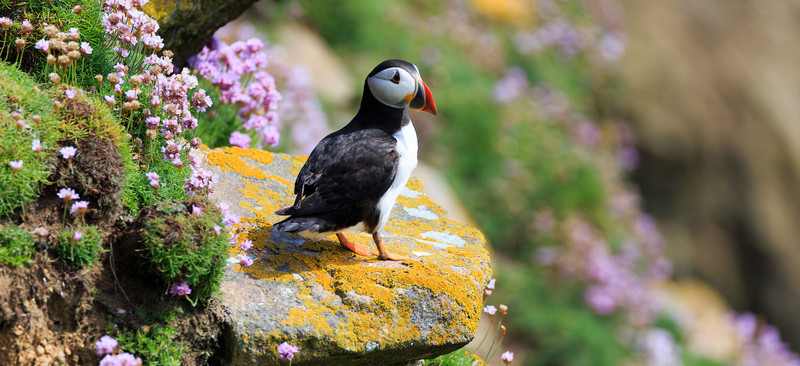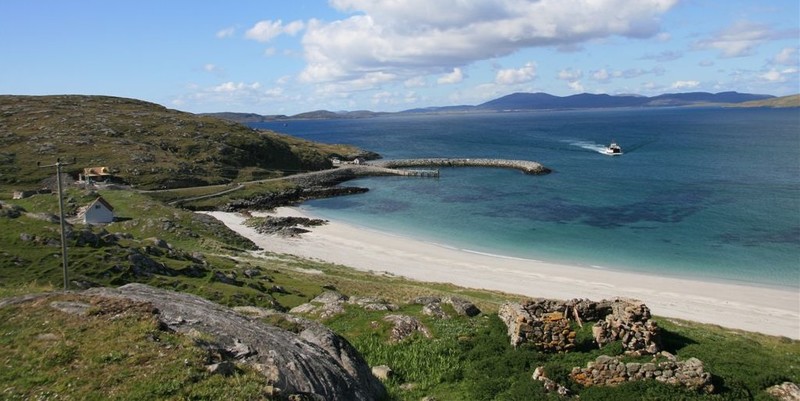The Hebrides - Magic & Mysteries
By Mike Deegan, Head of Fleet Operations
Mike recounts some of his favourite tales of Hebridean islands from missing Eilean Mor lighthouse keepers to the salvaging of precious whisky cargo off Eriskay. Discover the fascinating history of these remarkable islands that can easily be discovered about one of our small ship expedition cruises.
I have been lucky enough in my career to have sailed and travelled all over the world. From early voyages in the Far East and Pacific on elderly tankers to navigating up African rivers using a Philips School Atlas (yes, really!) I have enjoyed a career rich in the diversity of destinations travelled. However, it has been my privilege to spend many a summer in the Scottish Hebrides and on the west coast of the Scottish mainland. When asked where my favourites places are, the Hebrides are high up on the list.

To me the mere fact that every island is different, that every island has a fascinating tale to tell and that you can be “far from the madding crowd” on our own doorstep make these islands a destination of choice for Noble Caledonia guests where the smaller size of our ships ensures remote and isolated locations, beyond the reach of larger vessels, can be visited. The Hebrides feature heavily on our UK small ship cruise itineraries with most of the vessels including calls in and around the Hebrides on their summer voyages around the British Isles. So to whet your appetite I thought I would give you a flavour of the area with tales of some of the islands.
St Kilda is the most westerly Hebridean outpost being some 45 miles west of Benbecula, truly the outermost of the Outer Hebrides. In truth it is an archipelago not an island – the largest island in the group, and the site of our calls, is Hirta where we drop anchor in Village Bay. There is much conjecture as to the origin of the name St Kilda as no such saint existed. The most popular theories suggest it was a corruption of the Norse name for a well, Chulda, or there was a connection with a village Chieftain who may have lived there. Whatever the reality, the name St Kilda first appeared on maps around the mid 16th century. The island group itself is a UNESCO World Heritage Site, one of five in Scotland, and one of only a very few in the world with both natural and cultural significance.
Hirta was inhabited until 1930 when the privations of life there, the isolation, disease and the continuing decline of the local population as the young men left to seek work elsewhere, all contributed to the decision to evacuate the remaining population. The deserted village still stands on the foreshore where our Zodiacs land and to walk round it is eerie and peaceful in equal measure. Nowadays only the wildlife wardens reside there and then only in the summer.

The island, and the neighbouring islands of Soay and Boreray are vital breeding grounds for sea birds such as puffins, fulmars, gannets and petrels. If you rise early enough to take in the imposing stacs en route into Village Bay, 1000s of nesting pairs can be seen clinging to the sheer rock faces – the sight and sounds are an unforgettable experience. The word remote could have been coined to describe St Kilda – what better way to arrive in this isolated outpost of Scotland than aboard one of Noble Caledonia’s small ship expedition cruises.
To the north east of St Kilda is North Rona. This isolated outcrop of land, more remote even than St Kilda and omitted from many maps of the UK, is 71 miles north of the Butt of Lewis. Once inhabited, but now abandoned, it is generally thought to be the only British land, outside the Channel Islands, where German forces have stepped ashore during both World Wars as U Boat Commanders put in there to bag a sheep or two to provide fresh meat for those long Atlantic patrols! On our ship’s approach to or from St Kilda however, you may just catch a glimpse of the loom of an isolated lighthouse on the Flannan Isles close by and it is a story from there I wish to relate:
The islands are known locally as the Seven Hunters and a lighthouse stands atop the largest – Eilean Mor. The lighthouse, which still stands, must have been quite a feat of engineering in its day. Designed by David Stevenson, the stone and other materials had to be hauled up the 45 metre high cliffs from boats in the rough North Atlantic below and the structure when complete stood at 75 feet high. It was completed in 1899 and cost £6,900 to construct. A passing steamer in December 1900 noted that the light was not lit and he contacted the Superintendent of Lights who dispatched a vessel, SS Hesperus, from Oban to investigate. There were three keepers on the island (including a Relief who had stepped in at the last minute due to the illness of the regular keeper) but when the crew landed they could find no trace. The crew found closed gates to the compound, the light fuelled and maintained, two of the three sets of oilskins missing, the clock stopped and an overturned chair in the messroom. The last entry in the log was made at 9am on 15 December – 11 days earlier. Previous entries had noted ferocious storms which had battered the island. Despite an exhaustive search of the lighthouse and the island, no trace was ever found. On Boxing Day 1900, the Captain of the Hesperus, Captain Harvie, sent a telegram to his superiors which said in part:
A dreadful accident has happened at the Flannans. The three keepers, Ducat, Marshall and the Occasional have disappeared from the Island. The clocks were stopped and other signs indicated that the accident must have happened about a week ago. Poor fellows must have been blown over the cliffs or drowned trying to secure a crane or something like that.
Superstition in the Hebrides in the early 20th century was rife and local belief had it that the “Phantom of the Seven Hunters” had played a factor or that they had been abducted by a boatload of ghosts! Abduction by foreign spies featured large in wild speculation as did their having been devoured by a sea serpent or giant bird! Wilfred Gibson wrote his celebrated poem “Flannan Light” in 1912 which includes the lines:
Ay, though we hunted high and low
And hunted everywhere
Of the three men's fate we found no trace
Of any kind in any place
But a door ajar and an untouched meal
And an overtoppled chair...
Later Genesis recorded an album track ”The Mystery of Flannan Light.
In fact there was no over-turned meal, that was merely artistic licence. So what more can we discover from contemporary notes and the archives?
Scrutiny of the official investigation by Superintendent of Lights Muirhead reveals that it was his belief that two of the keepers (probably Ducat and Marshall as MacArthur’s oilskins were the only ones found still in the messroom) had got into difficulty securing some equipment or other on the west landing point in the storm and that MacArthur had dashed out in his short sleeves to help then all three were washed into the sea by a freak wave. However the last few log entries make interesting reading:
December 12. “Gale north by northwest. Sea lashed to fury. Never seen such a storm. Waves very high. Tearing at lighthouse. Everything shipshape. James Ducat irritable”.
Later that day. “Storm still raging, wind steady. Stormbound. Cannot go out. Ship passing sounding foghorn. Could see lights of cabins. Ducat quiet. Donald McArthur crying”.
December 13. “Storm continued through night. Wind shifted west by north. Ducat quiet. McArthur praying”.
Later: “Noon, grey daylight. Me, Ducat and McArthur prayed”.
On 14 December there was no entry in the log.
The final entry was made on a slate, which (under normal circumstances) would have been transferred to the logbook proper later on:
“December 15. 1pm. Storm ended, sea calm. God is over all”.
For a junior such as Marshall (who was noted to be keeping the log) to describe his superior (Ducat) as “irritable” was surprising in that day as such language was never used in official logs. Superintendent Muirhead recalled knowing all three personally and stated that he did not recall any being “particularly God-fearing or prone to prayer”. Finally, McArthur crying was a surprising entry: all who knew him recalled a strong character who was a bit of a fighter ashore and a man who in 40 years of lighthouse service must have seen his fair share of violent storms.
However it is the last entry which is the most revealing: given the entry was timed at 1pm on the 15th and we know the passing steamer noted the light to be unlit at about midnight that evening, it would appear that whatever happened to them happened in a period of calm after the storm sub-sided.
The loss is still felt at the Northern Lighthouse Board who continue to maintain Scotland’s navigational marks and lights to this day. The lighthouse still maintains a lonely vigil across the Atlantic, warning approaching ships of the Flannan Isles and nearby rocks. The last keepers left the island in 1971 when the light was automated, but if those walls could speak…..
Let me leave the last word to Superintendent Muirhead who stated in his official report dated 8 January 1901: “I visited them as lately as 7th December and have the melancholy recollection that I was the last person to shake hands with them and bid them adieu”.
Finally let me tell you a tale of whisky, theft or salvage, depending on your point of view, and a classic British film which was based on the saga….

Eriskay is one of the Outer Hebrides connected to its nearest neighbour South Uist by a causeway. It was purchased by its community in 2006 but has two main claims to fame. Firstly it was where Bonnie Prince Charlie landed from France on his ill fated Jacobite Uprising of 1745. More recently it was the scene of a notorious ship foundering which became infamous in the dark days of the World War II.
SS Politician was bound for Jamaica and New Orleans from Liverpool in February 1941. Owned by T&J Harrison Ltd of Liverpool, she displaced some 8000 tons (so about twice the size of Noble Caledonia’s fleet vessels) and was fast for her day – having been built for the transatlantic trades, she was capable of 14 knots. On the night in question, she was laden with a cargo of plumbing spares, engine spares, pianos but more interestingly 264,000 bottles of duty free whisky and £145,000 in UK bank notes.
On a stormy night, her watchkeepers no doubt confused by the wartime practice of extinguishing the lights on navigational marks at night, she ran aground off Eriskay and stranded on the beach. The crew were all saved and looked after well by the locals – but word soon leaked out about Politician’s precious cargo! Spurred on by a whisky shortage brought about by wartime rationing, local men put out to the wreck in any manner of small boats to “liberate” the cargo. As word spread boats came from as far away as Lewis to assist. In time, word reached the ears of the local Customs officials, specifically one Charles MacColl who was based in Mull. Whilst the locals, and local Police Officers, may have seen the removal of the cargo as salvage, he viewed it as nothing more than common theft and duty evasion – no duty had been paid – and set about flooding the island with Customs Officers, to conduct a thorough search to discover the whereabouts of the pilfered cargo. Locals resorted to ever more ingenious methods to conceal their ill gotten gains: the booty was hidden, buried, decanted or just plain drunk to evade the attentions of the ever present Customs men, but eventually charges were laid before Lochmaddy Sherriff’s Court. Whilst the initial penalties were paltry fines, MacColl saw to it, following a sustained campaign, later defendants were treated to lengthy prison sentences.
Meanwhile attempts to salvage the vessel achieved little success. The longer the vessel remained aground, the more of its cargo was “liberated”. So to the islanders utter astonishment, MacColl applied for, and received, permission to blow the wreck up. A large crowd gathered to watch the eventual explosion – their thoughts summed up by one of their number, Angus John Campbell who stated memorably “Dynamiting whisky. You would n’ think there would be men so crazy in the world t’ dae that!”
From time to time bottles still emerge from the wreck, the remains of which still lie, totally submerged, in the bay. In 1988 eight bottles which had been discovered were auctioned for £4000 in London.
Of the banknotes even less is known. Some 211,000 were salvaged legitimately from the wreck by the salvage company and the Police and destroyed. A further 2500 turned up over the following years in places as diverse as London, Liverpool, Canada, the US, Switzerland and Jamaica. It is reckoned some 76.000 notes were stolen that have never been recovered.
In 1947, Compton MacKenzie (who lived and is buried on the nearby island of Barra) was inspired to write his novel “Whisky Galore” about the Politician saga. The novel featured the fictional island of Todday. It was made into an Ealing Comedy in 1949 and starred Basil Radford, a youthful Gordon Jackson before his days as Hudson the butler in Upstairs Downstairs and as George Cowley in The Professionals, and included a cameo appearance by Compton MacKenizie himself!
Should you step ashore in Eriskay, be sure to visit the local pub, Am Politician (Gaelic for The Politician) which was opened in 1988 in celebration of one of the island’s most infamous events.
The area should be on everybody’s “to-do” list. Until you have experienced the stillness and remote calm of a landing at Loch Scavaig on Skye (and wandered up the rock path to view the peaceful Loch Corruisk above the sea water loch – look out for the seals on the Zodiac ride into the pier: they rarely see humans so retain their friendly and inquisitive manner), or trod where St Columba brought Christianity to these shores in Iona (where the Abbey and its Monastic Community still thrive) you have yet to experience the abundance of unforgettable experiences on our doorstep.
All the islands I include above are regularly included on Noble Caledonia itineraries in the Hebrides – I very much hope we shall be able to welcome you aboard one of our small ship cruises to share them with you in the not too distant future.





